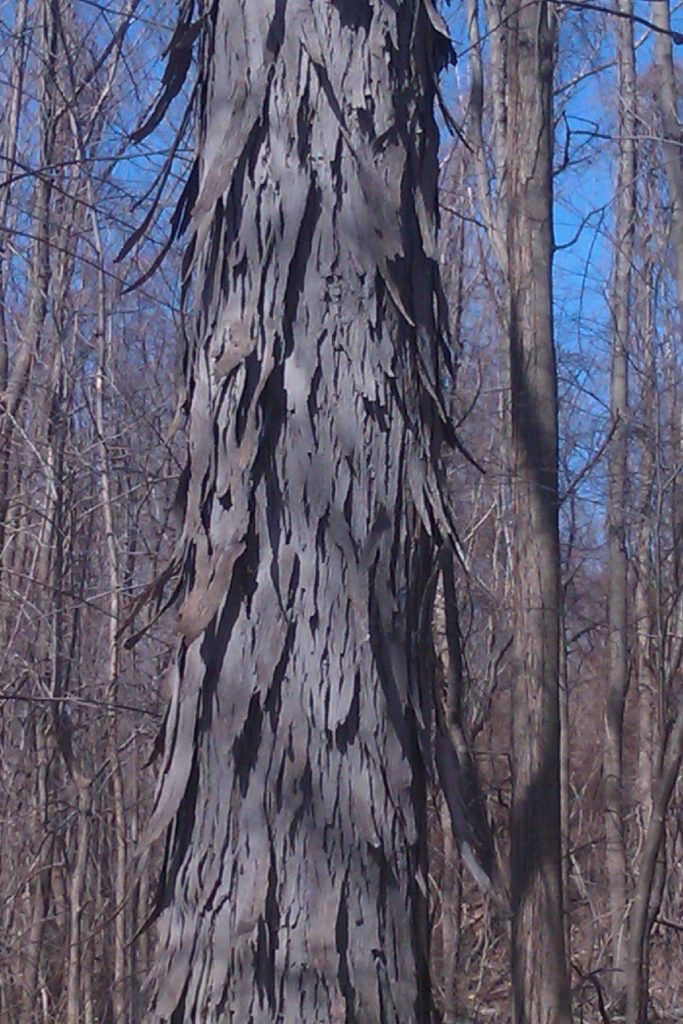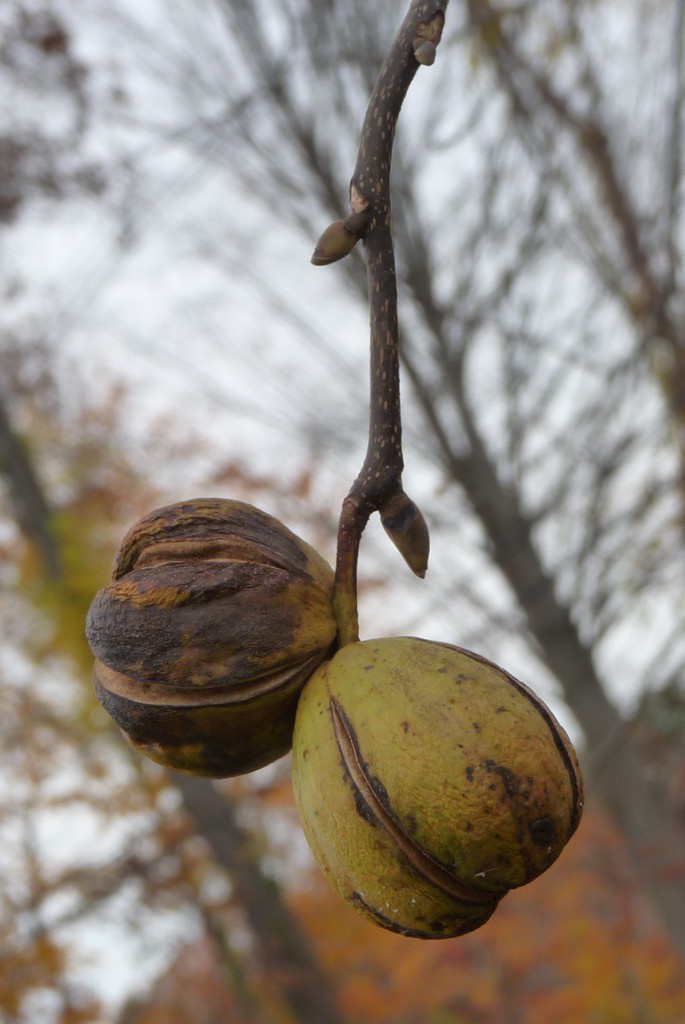Shagbark hickory (Carya ovata)
Tall, long-lived, member of the walnut family; stately, and moderately slow-growing; loose-plated bark and golden autumn color are strong landscape features; tolerant of a range of soil and moisture conditions, once established; found primarily in southern Maine, across southern Quebec and Ontario to Minnesota, south to eastern Texas and Georgia; a climax species of the Eastern hardwood forest.
By Pamela Johnson
All photos by Russ Cohen
 A winter’s walk into the woods on an afternoon of equivocal temperatures and minatory skies: a storm impends. Stifled light barely seeps through the trees. There is portentous calm. Occasional gusts begin to eddy among the treetops, but little stirs in the understory. The habitually companionable chickadees and nuthatches have vanished. There are no sibilances overhead from the aerialist kinglets, nor tittle-tattle or chastisement from red squirrels.
A winter’s walk into the woods on an afternoon of equivocal temperatures and minatory skies: a storm impends. Stifled light barely seeps through the trees. There is portentous calm. Occasional gusts begin to eddy among the treetops, but little stirs in the understory. The habitually companionable chickadees and nuthatches have vanished. There are no sibilances overhead from the aerialist kinglets, nor tittle-tattle or chastisement from red squirrels.
Braced silence and then the wind arrives in earnest, scouring all the forest’s density. Crowded upper limbs scrape, grapple, and clutch, as if wrestling with their neighbors for balance. The air is suddenly frigid and flinty with sleet. Turbulence descends through the canopy, roiling around trunks, shoving even the largest trees. Clattering, groans, squeals of wood against wood as each tree protests with a different, puling voice. The ground heaves underfoot as a shallow-rooted fir is wrenched by a gust. A crack, a thump, and a wind-axed tree is slain not far away. It is time to head for safety, leaving the forest to cope unwitnessed in its extremity.
How do trees defy the worst of winter weather, or even the daily assaults of wind, ice, bursts of intense, low-angled sunlight alternating with frigid nighttime temperatures? How will our trees fare as storms, in all seasons, strengthen and become more punishing? Why are some ostensibly healthy trees snapped or uprooted in tempests? And why do some trees succumb to disease or insect irruptions, while others of the same species, nearby, prevail?
The answers are found within the physiology of an individual tree (as well as within the constitution of the organism that is a forest[1]). Trees cannot move. They cannot depart for a more clement spot. Parts of trees have some mobility: roots travel to nutrients and around obstacles; apical growth reaches for sunlight and space; some leaves are phototropic, directing themselves toward light. However: if an acorn lands between two boulders and takes root in a crevice, the oak must live its constricted life where it began. Its only hope of “movement” is reproductive maturity that might allow its progeny to grow in more hospitable terrain- so seed dispersal is genetic mobility. Tree bark reinforces, as it thickens, a trees immobility; but it is also a tree’s bulwark against the elements; its defense against disease, insects, desiccation, mammalian browsings, fire, and other disturbances.
Bark is a non-scientific term for a tree’s outer dermis. Bark covers trunks, branches, and roots. While a sapling’s bark may be only a thin, photosynthesizing veneer, easily gouged by a fingernail, mature tree bark is an extraordinary pelt of strength and complexity, as well as a wily mix of protective chemicals. In decadence, tree bark harbors a forest’s worth of lichens, mosses, fungi, small vertebrates, invertebrates, and microorganisms.
When the ancestors of our trees appeared 200 to 300 million years ago they were 90% bark, a necessity to survive the ravishings of outsized herbivores and blundering megafauna. The proportion is now reversed with bark comprising not more than 10% of a tree’s mass. That one characteristic, bark, common to all the trees, is highly idiosyncratic, exhibiting great variety from species to species, and nuances even within a single species.
Among northern tree species there are a few barks which are instantly recognizable: paper birch’s (Betula papyrifera) American beech’s (Fagus grandifolia), and shagbark hickory’s (Carya ovata).
Shagbark hickory is a very shaggy-looking tree. Its dark charcoal bark is shingled with warped shreds not unlike the scabers of a mushroom stalk or coarse shavings from a very large chocolate bar. The shagbark hickory’s bark is lighter grey and smooth when the tree is young; the shagginess develops as the tree increases in girth. Bark patterns and characteristics are often more pronounced as a tree ages (furrows deepen, ridges extrude, exfoliation is more dramatic) reflecting the dynamic process that creates tree bark.
The Maine Forest Service’s 2008 Forest Trees of Maine lists two trees vying for designation as the largest shagbark hickory in the State: a tree in Falmouth, 89’ high and 116” in circumference, and one in Westbrook, 72’ in height and 133” around. Presumably both trees have added height and width in seven years, although shagbark hickories are moderately slow growers. Southern Maine (including parts of York, Cumberland, Kennebec, Androscoggin and Sagadahoc Counties) represents the northern limit of the shagbark’s range. There are shagbark hickories elsewhere in Maine but these were probably trees planted, and cultivated for their nuts. It is also true that as our climate warms shagbark hickories may move northward along with white oaks (another southern Maine forest species).
 Shagbark hickories live long lives, and forty years was considered the amount of time a tree took to reach its commercial nut-producing potential. Trees that are 200, even 300 years in age can still produce quantities of nuts. Mast years for forest shagbark hickories occur every one to three years and population spikes, among the mammals who eat shagbark nuts, may parallel years of bountiful crops wherever the trees are abundant (black bears, for instance, in states to the south).
Shagbark hickories live long lives, and forty years was considered the amount of time a tree took to reach its commercial nut-producing potential. Trees that are 200, even 300 years in age can still produce quantities of nuts. Mast years for forest shagbark hickories occur every one to three years and population spikes, among the mammals who eat shagbark nuts, may parallel years of bountiful crops wherever the trees are abundant (black bears, for instance, in states to the south).
Red squirrels, chipmunks, foxes, raccoons, mice, wood ducks, turkeys, mallards, cardinals and titmice all relish shagbark hickory nuts. Migrating yellow-rumped warblers and rose-breasted grosbeaks eat the nuts (which begin to ripen in September) along their routes south. The most prodigious appetite for shagbark hickory nuts belongs to grey squirrels. The competition for nuts between early settlers and squirrels in Pennsylvania prompted a bounty in the 1700’s (three pence per squirrel) that brought in 640,000 carcasses and nearly bankrupted the colonial treasury.
Native Americans relied upon shagbark hickory nuts whose meat is high in fat and protein, low in carbohydrates. The nuts are sweet and nourishing, and were a dietary staple. William Bartram’s Travels of 1791 describes the hickory “milk”, made from a slurry, that was called “pawohiccora” or “pawhiccori”. It is easy to trace the origin of Carya ovata’s common name from there.
Shagbark hickory nuts, bark and twigs were part of the indigenous pharmacopoeia. There were internal and external applications for a host of maladies. The wood itself was equally important and versatile. Shagbark hickory is a heavy wood which burns slowly. As a fuel, a cord of hickory yields the same amount of heat as a ton of bituminous coal.[2] Colonials used the wood for tool handles, basket-making, barrel and bucket hoops, and furniture-making.
More than 133 fungi are associated with shagbark hickories, but there are few which damage the tree seriously. Shagbark hickories also host approximately 180 species of insects and mites, but bark chemistry and architecture minimize their incursions.[3] Bats and brown creepers roost and nest, respectively, beneath the shagbark’s flaking bark.
The hickory horned devil, the larva of the royal walnut moth (Citheronia regalis), is a fearsome-looking caterpillar associated with shagbark hickories. The adult moth is, according to Douglas Tallamy, “one of the largest and most beautiful Lepidoptera in North America”. The moths once only ranged as far north as Massachusetts, and are said now to be gone from New England. One wonders, if, as the hickories extend northward, parts of New England might also get to experience these moths and their caterpillars.
Shagbark hickories have great dignity; their unique shaggy bark belies their longevity and strength. Once met, this is a tree well-remembered. Ease of identification is a step toward understanding the ecology of a forest. Winter is perhaps the best time to learn to recognize different tree species: bark is at eye level and there are fewer distractions. There is one book, Bark by Michael Wojtech, that in size and format can serve as a good field guide; Tree Bark by Hugues Vaucher covers much a greater number of trees, but does include New England species.
Hickory nuts ripen in September. Harvest the nuts as soon as they drop- squirrels provide steep competition. Remove the green husk and soak the nuts in a bucket of water overnight. Any nuts that float may be empty. Do not leave nuts sitting around at room temperature or the seeds will desiccate and lose viability. Plant nuts in a deep pot or cold frame, place outdoors, and protect from rodents with wire screening. Squirrels will find your pots within a couple of hours if unprotected. Seeds will germinate in the spring after winter stratification. Trees are tap-rooted, so transplant to a permanent location within a year.
[1] See Sally McGrane’s Saturday profile {NY Times, Jan. 30, 2016} of Peter Wohlleben and his The Hidden Life of Trees; Wohlleben, a German forester, bases his management practices on the interconnectedness and interdependency of trees in a forest.
[2] Rupp, Rebecca. 1990. Red Oaks and Black Birches. Pownal, Vermont: Storey Comms., Inc. p.84
[3] The most injurious insect is the hickory bark beetle (Scolytus quadrispinosa) whose larvae can girdle a tree; but since shagbark hickory here does not grow in pure stands, the damage is usually isolated.

